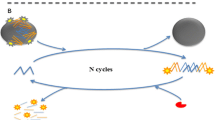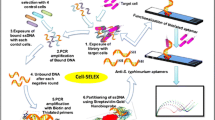Abstract
Salmonella enteritidis is one of the most common foodborne pathogens. Many methods have been developed to detect Salmonella, but most of them are expensive, time-consuming, and complex in experimental procedures. Developing a rapid, specific, cost-effective, and sensitive detection method is still demanded. In this work, a practical detection method is presented using salicylaldazine caprylate as the fluorescent probe, which could be hydrolyzed by caprylate esterase liberated from Salmonella lysed by phage, to form strong fluorescent salicylaldazine. The Salmonella could be detected accurately with a low limit of detection of 6 CFU/mL and a broad concentration range of 10–106 CFU/mL. Moreover, this method was successfully used for the rapid detection of Salmonella in milk within 2 h through pre-enrichment by ampicillin-conjugated magnetic beads. The novel combination of fluorescent turn-on probe salicylaldazine caprylate and phage ensures this method has excellent sensitivity and selectivity.
Graphical Abstract







Similar content being viewed by others
References
Wang M, Zhang Y, Tian F, Liu X, Du S, Ren G. Overview of rapid detection methods for Salmonella in foods: progress and challenges. Foods. 2021;10(10):2402. https://doi.org/10.3390/foods10102402.
Majowicz SE, Musto J, Scallan E, Angulo FJ, Kirk M, O’Brien SJ, Jones TF, Fazil A, Hoekstra RM. The global burden of nontyphoidal Salmonella gastroenteritis. Clin Infect Dis. 2010;50(6):882–9. https://doi.org/10.1086/650733.
Man Y, Ban M, Li A, Jin X, Du Y, Pan L. A microfluidic colorimetric biosensor for in-field detection of Salmonella in fresh-cut vegetables using thiolated polystyrene microspheres, hose-based microvalve and smartphone imaging APP. Food Chem. 2021;354:129578. https://doi.org/10.1016/j.foodchem.2021.129578.
Wu S, Hulme JP. Recent advances in the detection of antibiotic and multi-drug resistant Salmonella: an update. Int J Mol Sci. 2021;22(7):3499. https://doi.org/10.3390/ijms22073499.
Salam F, Uludag Y, Tothill IE. Real-time and sensitive detection of Salmonella Typhimurium using an automated quartz crystal microbalance (QCM) instrument with nanoparticles amplification. Talanta. 2013;115:761–7. https://doi.org/10.1016/j.talanta.2013.06.034.
Zhuang QQ, He SB, Jiang YC, Huang KY, Xu YY, Peng HP, Deng HH, Chen W. Immunofluorescent-aggregation assay based on anti-Salmonella typhimurium IgG-AuNCs, for rapid detection of Salmonella typhimurium. Microchim Acta. 2022;189(4):160. https://doi.org/10.1007/s00604-022-05263-z.
Udomkarnjananun S, Kerr SJ, Francke MI, Avihingsanon Y, van Besouw NM, Baan CC, Hesselink DA. A systematic review and meta-analysis of enzyme-linked immunosorbent spot (ELISPOT) assay for BK polyomavirus immune response monitoring after kidney transplantation. J Clin Virol. 2021;140:104848. https://doi.org/10.1016/j.jcv.2021.104848.
Zhao S, Bu T, Yang K, Xu Z, Bai F, He K, Li L, Wang L. Immunochromatographic assay based on polydopamine-decorated iridium oxide nanoparticles for the rapid detection of salbutamol in food samples. ACS Appl Mater Interfaces. 2021;13(24):28899–907. https://doi.org/10.1021/acsami.1c06724.
Dehghani Z, Nguyen T, Golabi M, Hosseini M, Rezayan AH, Mohammadnejad J, Wolff A, Vinayaka AC. Magnetic beads modified with Pt/Pd nanoparticle and aptamer as a catalytic nano-bioprobe in combination with loop mediated isothermal amplification for the on-site detection of Salmonella Typhimurium in food and fecal samples. Food Control. 2021;121:107644. https://doi.org/10.1016/j.foodcont.2020.107664.
Huang Y, Chen W, Chung J, Yin J, Yoon J. Recent progress in fluorescent probes for bacteria. Chem Soc Rev. 2021;50(13):7725–44. https://doi.org/10.1039/d0cs01340d.
Qi W, Zheng L, Wang S, Huang F, Liu Y, Jiang H, Lin J. A microfluidic biosensor for rapid and automatic detection of Salmonella using metal-organic framework and raspberry Pi. Biosens Bioelectron. 2021;178:113020. https://doi.org/10.1016/j.bios.2021.113020.
Ren Y, Wei J, He Y, Wang Y, Bai M, Zhang C, Luo L, Wang J, Wang Y. Ultrasensitive label-free immunochromatographic strip sensor for Salmonella determination based on salt-induced aggregated gold nanoparticles. Food Chem. 2021;343:128518. https://doi.org/10.1016/j.foodchem.2020.128518.
Kim J-H, Oh S-W. Rapid and sensitive detection of E. coli O157:H7 and S. Typhimurium in iceberg lettuce and cabbage using filtration, DNA concentration, and qPCR without enrichment. Food Chem. 2020;327:127036 https://doi.org/10.1016/j.foodchem.2020.127036.
Du M, Li J, Liu Q, Wang Y, Chen E, Kang F, Tu C. Rapid detection of trace Salmonella in milk using an effective pretreatment combined with droplet digital polymerase chain reaction. Microbiol Res. 2021;251:126838. https://doi.org/10.1016/j.micres.2021.126838.
Lim HJ, Kang ER, Park MY, Kim BK, Kim MJ, Jung S, Roh KH, Sung N, Yang JH, Lee MW, Lee SH, Yang YJ. Development of a multiplex real-time PCR assay for the simultaneous detection of four bacterial pathogens causing pneumonia. PLoS One. 2021;16(6):e0253402. https://doi.org/10.1371/journal.pone.0253402.
Zheng S, Yang X, Zhang B, Cheng S, Han H, Jin Q, Wang C, Xiao R. Sensitive detection of Escherichia coli O157:H7 and Salmonella typhimurium in food samples using two-channel fluorescence lateral flow assay with liquid Si@quantum dot. Food Chem. 2021;363:130400. https://doi.org/10.1016/j.foodchem.2021.130400.
Huang R, Li M, Lin D, Shao Y, Shang C, Liu Q, Liu G, Li N, Miao R, Peng H, Tang Y, Fang Y. A fluorescent film sensor for high-performance detection of Listeria monocytogenes via vapor sampling. Aggregate. 2022;3:e203. https://doi.org/10.1002/agt2.203.
Mei J, Leung NL, Kwok RT, Lam JW, Tang BZ. Aggregation-induced emission: together we shine, united we soar! Chem Rev. 2015;115(21):11718–940. https://doi.org/10.1021/acs.chemrev.5b00263.
Kang S, Jung Y, Jung J, Park K-H, Kim D. Bacteria-dye combination screening: diamine-containing BMeS-p-A dye for specific fluorescence imaging of Acinetobacter baumannii. Dyes and Pigments. 2021;185:108939. https://doi.org/10.1016/j.dyepig.2020.108939.
Qi G, Hu F, Kenry Shi L, Wu M, Liu B. An AIEgen-peptide conjugate as a phototheranostic agent for phagosome-entrapped bacteria. Angew Chem Int Ed. 2019;58(45):16229–35. https://doi.org/10.1002/anie.201906099.
Xie Y, Li Z. Development of aggregated state chemistry accelerated by aggregation-induced emission. Natl Sci Rev. 2020;8(6):nwaa199. https://doi.org/10.1093/nsr/nwaa199.
Luo J, Xie Z, Lam JW, Cheng L, Chen H, Qiu C, Kwok HS, Zhan X, Liu Y, Zhu D, Tang BZ. Aggregation-induced emission of 1-methyl-1,2,3,4,5-pentaphenylsilole. Chem Commun. 2001;18:1740–1. https://doi.org/10.1039/b105159h.
Mei J, Hong Y, Lam JW, Qin A, Tang Y, Tang BZ. Aggregation-induced emission: the whole is more brilliant than the parts. Adv Mater. 2014;26(31):5429–79. https://doi.org/10.1002/adma.201401356.
Cai X, Liu B. Aggregation-induced emission: recent advances in materials and biomedical applications. Angew Chem Int Ed. 2020;59(25):9868–86. https://doi.org/10.1002/anie.202000845.
Balachandran YL, Jiang X. Aggregation-induced fluorogens in bio-detection, tumor imaging, and therapy: a review. CCS Chem. 2022;4(2):420–36. https://doi.org/10.31635/ccschem.021.202101307.
Yoon J. Turning an FDA-approved therapeutic into an AIEgen for imaging live bacteria and for bacterial detection. Aggregate. 2021;2:e47. https://doi.org/10.1002/agt2.47.
Tang W, Xiang Y, Tong A. Salicylaldehyde azines as fluorophores of aggregation-induced emission enhancement characteristics. J Org Chem. 2009;74(5):2163–6. https://doi.org/10.1021/jo802631m.
Wang Z, Zhou F, Wang J, Zhao Z, Qin A, Yu Z, Tang BZ. Electronic effect on the optical properties and sensing ability of AIEgens with ESIPT process based on salicylaldehyde azine. Sci China Chem. 2018;61(1):76–87. https://doi.org/10.1007/s11426-017-9147-0.
Zhang R, Gao M, Bai S, Liu B. A fluorescent light-up platform with “AIE + ESIPT” characteristics for multi-target detection both in solution and on paper strip. J Mater Chem B. 2015;3:1590–6. https://doi.org/10.1039/C4TB01937G.
Cui L, Baek Y, Lee S, Kwona N, Yoon J. An AIE and ESIPT based kinetically resolved fluorescent probe for biothiols. J Mater Chem C. 2016;4:2909–14. https://doi.org/10.1039/C5TC03272E.
Pulkkinen EM, Hinkley TC, Nugen SR. Utilizing in vitro DNA assembly to engineer a synthetic T7 Nanoluc reporter phage for Escherichia coli detection. Integr Biol. 2019;11(3):63–8. https://doi.org/10.1093/intbio/zyz005.
Niyomdecha S, Limbut W, Numnuam A, Kanatharana P, Charlermroj R, Karoonuthaisiri N, Thavarungkul P. Phage-based capacitive biosensor for Salmonella detection. Talanta. 2018;188:658–64. https://doi.org/10.1016/j.talanta.2018.06.033.
Paczesny J, Richter L, Holyst R. Recent progress in the detection of bacteria using bacteriophages: a review. Viruses. 2020;12(8):845. https://doi.org/10.3390/v12080845.
Meile S, Kilcher S, Loessner MJ, Dunne M. Reporter phage-based detection of bacterial pathogens: design guidelines and recent developments. Viruses. 2020;12(9):944. https://doi.org/10.3390/v12090944.
Bu T, Yao X, Huang L, Dou L, Zhao B, Yang B, Li T, Wang J, Zhang D. Dual recognition strategy and magnetic enrichment based lateral flow assay toward Salmonella enteritidis detection. Talanta. 2020;206:120204. https://doi.org/10.1016/j.talanta.2019.120204.
Huang C, Mahboubat BY, Ding Y, Yang Q, Wang J, Zhou M, Wang X. Development of a rapid Salmonella detection method via phage-conjugated magnetic bead separation coupled with real-time PCR quantification. Lwt. 2021;142:111075. https://doi.org/10.1016/j.lwt.2021.111075.
Ding Y, Zhang Y, Huang C, Wang J, Wang X. An endolysin LysSE24 by bacteriophage LPSE1 confers specific bactericidal activity against multidrug-resistant Salmonella strains. Microorganisms. 2020;8(5):737. https://doi.org/10.3390/microorganisms8050737.
Kunushpayeva Z, Rapikov A, Akhmetova A, Sultangaziyev A, Dossym D, Bukasov R. Sandwich SERS immunoassay of human immunoglobulin on silicon wafer compared to traditional SERS substrate, gold film. Sens Biosensing Res. 2020;29:100355. https://doi.org/10.1016/j.sbsr.2020.100355.
Funding
This work was financially supported by the Fundamental Research Funds for the Central Universities (No. 2662019QD032) and the National Key Research and Development Program of China (2017YFE0113900).
Author information
Authors and Affiliations
Corresponding authors
Ethics declarations
Conflict of interest
The authors declare no competing interests.
Additional information
Publisher's note
Springer Nature remains neutral with regard to jurisdictional claims in published maps and institutional affiliations.
Supplementary information
Below is the link to the electronic supplementary material.
Rights and permissions
Springer Nature or its licensor (e.g. a society or other partner) holds exclusive rights to this article under a publishing agreement with the author(s) or other rightsholder(s); author self-archiving of the accepted manuscript version of this article is solely governed by the terms of such publishing agreement and applicable law.
About this article
Cite this article
Zhang, H., Wang, X., Xu, Z. et al. A caprylate esterase–activated fluorescent probe for sensitive and selective detection of Salmonella enteritidis. Anal Bioanal Chem 415, 2163–2172 (2023). https://doi.org/10.1007/s00216-023-04623-9
Received:
Revised:
Accepted:
Published:
Issue Date:
DOI: https://doi.org/10.1007/s00216-023-04623-9




